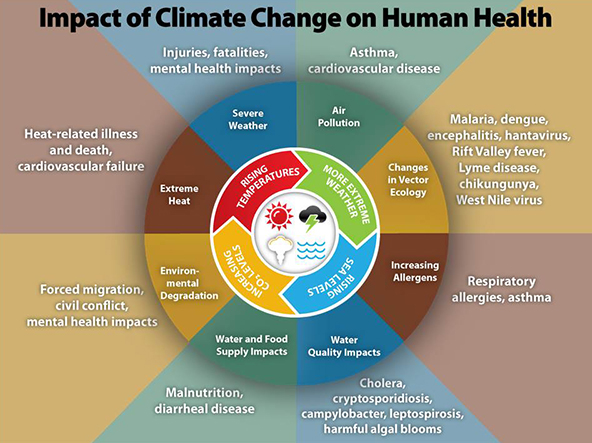Climate Change Impacts Children
Published: August 11, 2021
Check out our video about how climate change impacts children.
What is Climate change?
Climate change is “any change in average weather that lasts for a long period of time, like warming temperatures.” Climate change can cause extreme heat, flooding, wildfires, and other natural disasters. These natural disasters could be flooding, wildfires, heat waves, etc.
Why should we care?
Living in a humid subtropical climate, Texans are no strangers to heat. However, temperatures in Texas are expected to reach uncomfortable and potentially dangerous levels. Across the state, climate change is projected to increase average temperatures by 3.6–5.1°F by the year 2050 (compared to average temperatures for 1976–2005) and to increase the frequency, intensity, and duration of extreme heat events. If global greenhouse gas emissions continue unabated, the region is expected to experience an additional 30–60 days per year above 100°F by the end of the century.
Furthermore, city residents are subjected to higher temperatures than others due to heat islands, defined as “urbanized areas that experience higher temperatures than outlying areas. Structures such as buildings, roads, and other infrastructure absorb and re-emit the sun’s heat more than natural landscapes such as forests and water bodies” (EPA).
Impacts of Climate Change on Human Health
Below is a very helpful visual demonstrating the “Impacts of Climate Change on Human Health”

CHILDREN are more vulnerable to the impacts of climate change for unique reasons:
- They are growing
- Grow and develop from infancy to adolescence
- More sensitive to environmental changes related to the climate
- Unique Behaviors and Interactions with the Environment
- Children’s behaviors increase their exposure to certain health threats
- Children play outside often and may not recognize the signs of becoming dehydrated or overheated
- Dependency on Adult Caregivers
- Children separated from their caregivers during weather events, such as during storms floods, and heat waves are at increased risk of health impacts because they are not independent
Michael & Susan Dell Post-Doctoral Fellow Dr. Kevin Lanza, an expert in climate change as it relates to children, states:
“Extreme heat is a substantial threat to child health. Physiologically, children are particularly vulnerable to heat illness such as heat exhaustion and heat stroke due to their relatively low sweat rates and because their mobility and mental functioning are still developing. Second, extreme heat may make it too uncomfortable for children to want to play outside, a significant issue since currently most school-age children in the US are not reaching the recommended 60 minutes of physical activity daily and therefore missing the proven benefits for physical and mental health. Further, children engaging in physical activity in extreme heat are at an elevated risk of heat illness because their core body temperatures are increasing from being active and exposed to high temperatures in tandem.”
What can we do?
Although climate change can be an unsettling subject there are potential solutions:
MITIGATION vs ADAPTATION as solutions
- Mitigation
- reducing climate change – reducing greenhouse gases into the atmosphere
- Adaptation
- adapting to life in a changing climate – adjusting aspects of life to the new climate
SOLUTIONS:
- Add more green spaces (Mitigation and Adaptation- reduces climate change and involves adjusting to climate change)
- Plant more trees in your yard or volunteer with local non-profit to plant trees
- Can increase shade and Oxygen 1
- Volunteer in Austin
- Can increase shade and Oxygen 1
- Adding greenery to roofs (green roofs)
- can decrease the heat buildings give off
- Michael & Susan Dell Post-Doctoral Fellow, Dr. Kevin Lanza, the Principal Investigator of the Green Schoolyards Project helps run this project looking at how trees, gardens, and nature trails at three joint-use elementary school parks in Austin impact temperatures within parks and physical activity levels of predominantly Latinx children from low-income families. Adding more green spaces could be a potential solution to elevated temperatures due to climate change.
- Principal Investigator Dr. Kevin Lanza reported that “Baseline findings revealed that heat index (i.e., air temperature and relative humidity) reached as high as 114.1°F at an unshaded playground compared to 103.4°F at a playground under tree canopy. As a result, children were more likely to seek tree shade in higher temperatures than in lower temperatures.”
- This shows how impactful shade can be in a park where children play
- Principal Investigator Dr. Kevin Lanza reported that “Baseline findings revealed that heat index (i.e., air temperature and relative humidity) reached as high as 114.1°F at an unshaded playground compared to 103.4°F at a playground under tree canopy. As a result, children were more likely to seek tree shade in higher temperatures than in lower temperatures.”
- Michael & Susan Dell Post-Doctoral Fellow Dr. Kevin Lanza notes that “In addition to planting trees and adding shade structures at parks and sport facilities, schools can schedule physical education classes and sporting events during cooler times of day to protect children in our warming world.”
- Plant more trees in your yard or volunteer with local non-profit to plant trees
- Changing mode of transportation (Mitigation- reducing climate change)
- Switching your mode of commuting from car to walking results in a decrease in greenhouse gas emissions and therefore is a strategy to mitigate climate change
- Driving a hybrid or electric vehicle
- Riding a bike
- Taking public transportation more often
- Bus stop shelter (Adaptation- adjusting to climate change)
- Putting in a shade structure over a bus stop to help reduce the temperature at the bus stop
Resources for heat safety in Texas:
- http://austintexas.gov/page/heat-awareness#:~:text=Heat%20Safety%20Tips&text=Watch%20for%20signs%20of%20heat,are%20working%20or%20playing%20outside.&text=Actions:%20Call%209-1-1.&text=If%20symptoms%20last%20longer%20than,move%20to%20a%20cooler%20location
- https://austintexas.gov/page/summer-safety
- https://tpwd.texas.gov/state-parks/park-information/heat-safety-info
- https://www.dshs.texas.gov/heat
- https://txssc.txstate.edu/tools/weather-toolkit/drought
Contact Info:
Michael & Susan Dell Post-Doctoral Fellow
Dr. Kevin Lanza



Discussion